人教版必修五第四单元单词 教学案
- 格式:pdf
- 大小:194.65 KB
- 文档页数:7
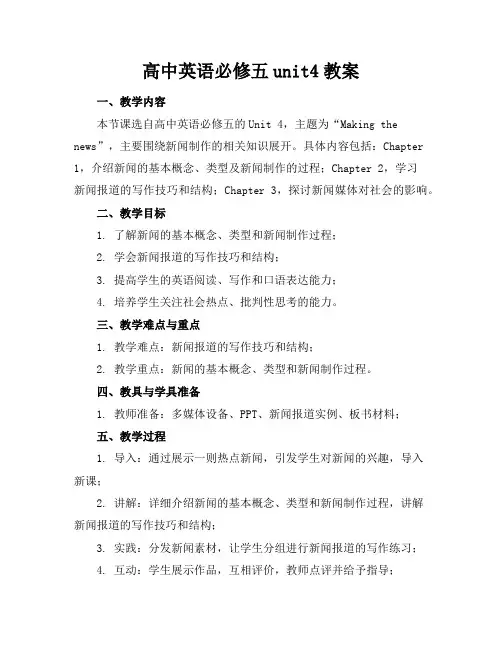
高中英语必修五unit4教案一、教学内容本节课选自高中英语必修五的Unit 4,主题为“Making the news”,主要围绕新闻制作的相关知识展开。
具体内容包括:Chapter 1,介绍新闻的基本概念、类型及新闻制作的过程;Chapter 2,学习新闻报道的写作技巧和结构;Chapter 3,探讨新闻媒体对社会的影响。
二、教学目标1. 了解新闻的基本概念、类型和新闻制作过程;2. 学会新闻报道的写作技巧和结构;3. 提高学生的英语阅读、写作和口语表达能力;4. 培养学生关注社会热点、批判性思考的能力。
三、教学难点与重点1. 教学难点:新闻报道的写作技巧和结构;2. 教学重点:新闻的基本概念、类型和新闻制作过程。
四、教具与学具准备1. 教师准备:多媒体设备、PPT、新闻报道实例、板书材料;五、教学过程1. 导入:通过展示一则热点新闻,引发学生对新闻的兴趣,导入新课;2. 讲解:详细介绍新闻的基本概念、类型和新闻制作过程,讲解新闻报道的写作技巧和结构;3. 实践:分发新闻素材,让学生分组进行新闻报道的写作练习;4. 互动:学生展示作品,互相评价,教师点评并给予指导;6. 课后作业布置:布置相关作业,巩固所学知识。
六、板书设计1. 新闻基本概念、类型;2. 新闻制作过程;3. 新闻报道写作技巧和结构;4. 课堂练习及答案。
七、作业设计1. 作业题目:请以“校园新闻”为主题,写一篇新闻报道;八、课后反思及拓展延伸1. 反思:本节课教学过程中,关注学生的学习反馈,针对学生掌握不牢固的部分进行巩固;2. 拓展延伸:鼓励学生关注国内外热点新闻,提高英语阅读水平,学会用英语表达自己的观点。
同时,组织学生进行新闻讨论,培养批判性思维。
在教学过程中,注重实践情景引入,例题讲解和随堂练习,使学生在实际操作中掌握知识,提高能力。
通过严谨的用词和流畅的段落衔接,确保教学效果。
重点和难点解析1. 教学难点与重点的明确;2. 教学过程中的实践情景引入;3. 作业设计及课后反思与拓展延伸。
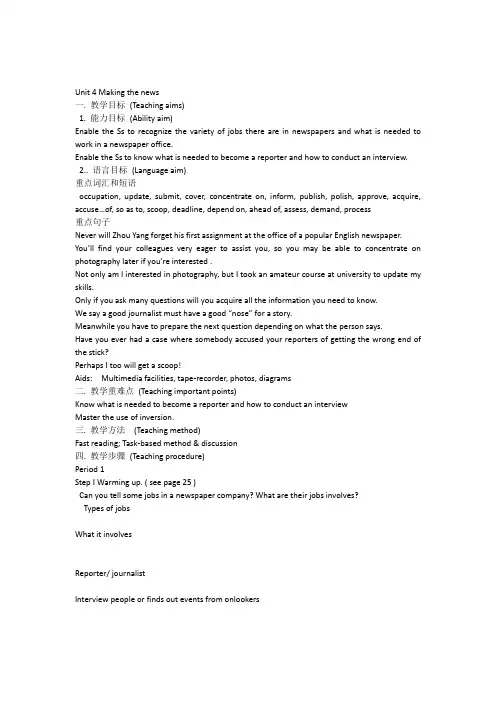
Unit 4 Making the news一. 教学目标(Teaching aims)1. 能力目标(Ability aim)Enable the Ss to recognize the variety of jobs there are in newspapers and what is needed to work in a newspaper office.Enable the Ss to know what is needed to become a reporter and how to conduct an interview. 2.. 语言目标(Language aim)重点词汇和短语occupation, update, submit, cover, concentrate on, inform, publish, polish, approve, acquire, accuse…of, so as to, scoop, deadline, depend on, ahead of, assess, demand, process重点句子Never will Zhou Yang forget his first assignment at the office of a popular English newspaper. You’ll find your colleagues very eager to assist you, so you may be able to concentrate on photography later if you’re interested .Not only am I interested in photography, but I took an amateur course at university to update my skills.Only if you ask many questions will you acquire all the information you need to know.We say a good journalist must have a good “nose” for a story.Meanwhile you have to prepare the next question depending on what the person says.Have you ever had a case where somebody accused your reporters of getting the wrong end of the stick?Perhaps I too will get a scoop!Aids: Multimedia facilities, tape-recorder, photos, diagrams二. 教学重难点(Teaching important points)Know what is needed to become a reporter and how to conduct an interviewMaster the use of inversion.三. 教学方法(Teaching method)Fast reading; Task-based method & discussion四. 教学步骤(Teaching procedure)Period 1Step I Warming up. ( see page 25 )Can you tell some jobs in a newspaper company? What are their jobs involves?Types of jobsWhat it involvesReporter/ journalistInterview people or finds out events from onlookersPhotographerTakes photos of important people or eventsEditorMakes sure the writing is clear, concise and accurate, check factsDesignerLays out the articles and photographsPrinterPrints the newspaperTeaching suggestions: rearrange the order of the types of jobs a newspaper has and what they involveAnd ask the students to do the matches. Then ask them to copy what’s on the screen to their books.At the same time deal with the new words:occupation and journalist and the expression: suppose you were…occupation =a job or professionTeaching is my occupation. 教书是我的职业.。
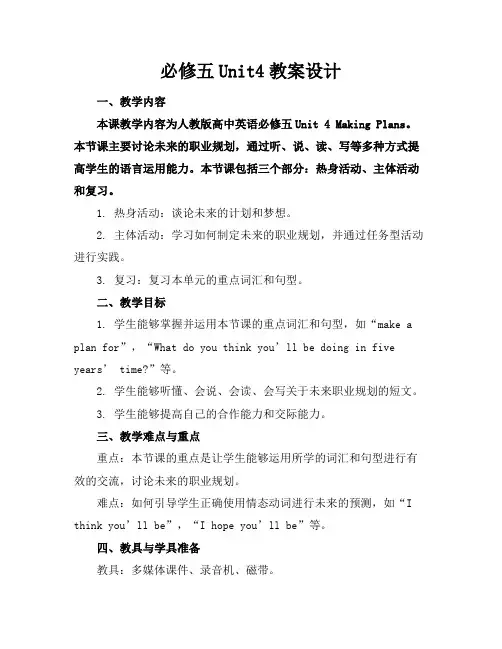
必修五Unit4教案设计一、教学内容本课教学内容为人教版高中英语必修五Unit 4 Making Plans。
本节课主要讨论未来的职业规划,通过听、说、读、写等多种方式提高学生的语言运用能力。
本节课包括三个部分:热身活动、主体活动和复习。
1. 热身活动:谈论未来的计划和梦想。
2. 主体活动:学习如何制定未来的职业规划,并通过任务型活动进行实践。
3. 复习:复习本单元的重点词汇和句型。
二、教学目标1. 学生能够掌握并运用本节课的重点词汇和句型,如“make a plan for”,“What do you think you’ll be doing in five years’ time?”等。
2. 学生能够听懂、会说、会读、会写关于未来职业规划的短文。
3. 学生能够提高自己的合作能力和交际能力。
三、教学难点与重点重点:本节课的重点是让学生能够运用所学的词汇和句型进行有效的交流,讨论未来的职业规划。
难点:如何引导学生正确使用情态动词进行未来的预测,如“I think you’ll be”,“I hope you’ll be”等。
四、教具与学具准备教具:多媒体课件、录音机、磁带。
学具:课本、练习册、铅笔、橡皮。
五、教学过程1. 热身活动(5分钟)教师提问学生关于未来的计划和梦想,引导学生进行自由的交流,如:“What do you want to be when you grow up?”,“What are your plans for the future?”等。
2. 主体活动(20分钟)(1)教师引导学生学习本节课的重点词汇和句型,如“make a plan for”,“What do you think you’ll be doing in five years’ time?”等。
(2)学生进行小组活动,根据所学的词汇和句型,制定一个关于未来职业规划的短文。
(3)教师选取几个小组的短文进行展示,并让学生进行评价和修改。
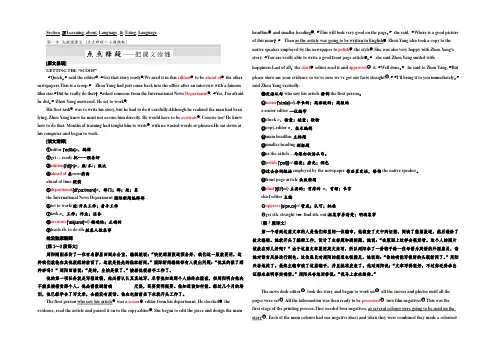
Section_ⅣLearning_about_Language_&_Using_Language[原文呈现]GETTING THE “SCOOP”“Quick,”said the editor①.“Get that story ready②.We need it in this edition③to be ahead of④the other newspapers.This is a scoop.”Zhou Yang had just come back into the office after an interview with a famous film star.“Did he really do that?”asked someone from the International News Department⑤. “Yes, I'm afraid he did,”Zhou Yang answered. He set to work⑥.His first task⑦was to write his story, but he had to do it carefully.Although he realized the man had been lying, Zhou Yang knew he must not accuse him directly. He would have to be accurate⑧. Concise too! He knew how to do that. Months of training had taught him to write⑨with no wasted words or phrases.He sat down at his computer and began to work.[读文清障]①editor ['edItə]n.编辑②get ... ready把……预备好③edition[I'dIʃn]n.版(本);版次④ahead of在……前面ahead of time提前⑤department[dI'pɑːtmənt]n.部门;部;处;系the International News Department国际新闻编辑部⑥set to work(使)开头工作;着手工作⑦task n.工作;作业;任务⑧accurate['ækjʊrət]adj.精确的;正确的⑨teach sb. to do sth.教某人做某事抢发独家新闻[第1~2段译文]周阳刚刚采访了一位有名影星回到办公室,编辑就说:“快把那篇报道预备好,我们这一版就要用,这样我们就抢在其他报纸的前面了,这就是抢先的独家新闻。
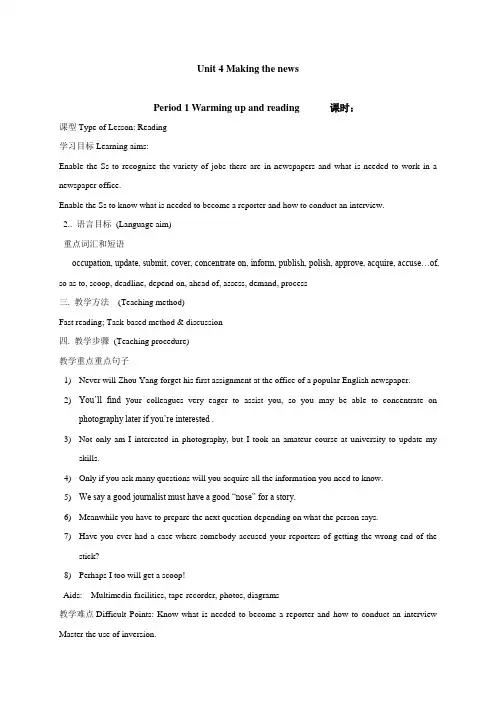
Unit 4 Making the newsPeriod 1 Warming up and reading 课时:课型Type of Lesson: Reading学习目标Learning aims:Enable the Ss to recognize the variety of jobs there are in newspapers and what is needed to work in a newspaper office.Enable the Ss to know what is needed to become a reporter and how to conduct an interview.2.. 语言目标(Language aim)重点词汇和短语occupation, update, submit, cover, concentrate on, inform, publish, polish, approve, acquire, accuse…of, so as to, scoop, deadline, depend on, ahead of, assess, demand, process三. 教学方法(Teaching method)Fast reading; Task-based method & discussion四. 教学步骤(Teaching procedure)教学重点重点句子1)Never will Zhou Yang forget his first assignment at the office of a popular English newspaper.2)You’ll find y our colleagues very eager to assist you, so you may be able to concentrate onphotography later if you’re interested .3)Not only am I interested in photography, but I took an amateur course at university to update myskills.4)Only if you ask many questions will you acquire all the information you need to know.5)We say a good journalist must have a good “nose” for a story.6)Meanwhile you have to prepare the next question depending on what the person says.7)Have you ever had a case where somebody accused your reporters of getting the wrong end of thestick?8)Perhaps I too will get a scoop!Aids: Multimedia facilities, tape-recorder, photos, diagrams教学难点Difficult Points: Know what is needed to become a reporter and how to conduct an interview Master the use of inversion.教学反思Teaching Re-thinking:家庭作业Homework:教学过程Teaching Procedures:一. 教学目标(Teaching aims)1. 能力目标(Ability aim)Period 1Step I Warming up. ( see page 25 )Can you tell some jobs in a newspaper company? What are their jobs involves?Teaching suggestions: rearrange the order of the types of jobs a newspaper has and what they involve And ask the students to do the matches. Then ask them to copy what’s on the screen to their books. At the same time deal with the new words:occupation and journalist and the expression: suppose you were…occupation =a job or professionTeaching is my occupation. 教书是我的职业.。
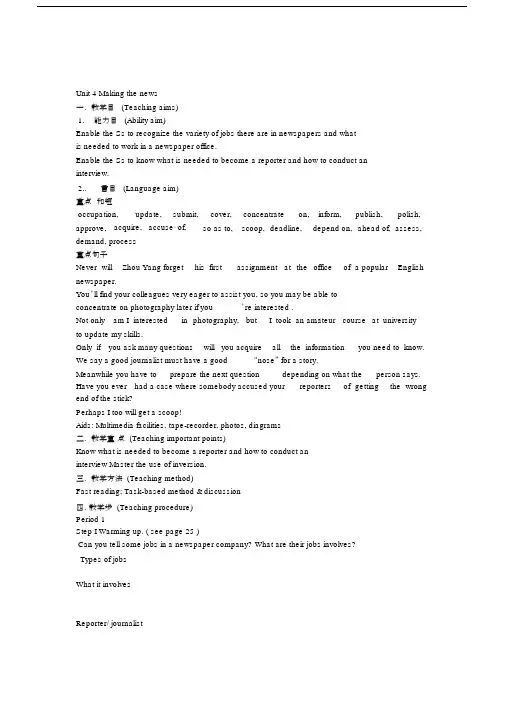
Unit 4 Making the news一.教学目 (Teaching aims)1.能力目 (Ability aim)Enable the Ss to recognize the variety of jobs there are in newspapers and whatis needed to work in a newspaper office.Enable the Ss to know what is needed to become a reporter and how to conduct aninterview.2..言目 (Language aim)重点和短occupation,update,submit,cover,concentrate on,inform,publish,polish, approve,acquire, accuse⋯of,so as to,scoop,deadline,depend on,ahead of, assess, demand, process重点句子Never will Zhou Yang forget his first assignment at the office of a popular English newspaper.You’ll find your colleagues very eager to assist you, so you may be able toconcentrate on photography later if you’re interested .Not only am I interested in photography, but I took an amateur course at universityto update my skills.Only if you ask many questions will you acquire all the information you need to know. We say a good journalist must have a good“nose” for a story.Meanwhile you have to prepare the next question depending on what the person says. Have you ever had a case where somebody accused your reporters of getting the wrong end of the stick?Perhaps I too will get a scoop!Aids: Multimedia facilities, tape-recorder, photos, diagrams二.教学重点 (Teaching important points)Know what is needed to become a reporter and how to conduct aninterview Master the use of inversion.三.教学方法 (Teaching method)Fast reading; Task-based method & discussion四.教学步 (Teaching procedure)Period 1Step I Warming up. ( see page 25 )Can you tell some jobs in a newspaper company? What are their jobs involves?Types of jobsWhat it involvesReporter/ journalistInterview people or finds out events from onlookersPhotographerTakes photos of important people or eventsEditorMakes sure the writing is clear, concise and accurate, check factsDesignerLays out the articles and photographsPrinterPrints the newspaperTeaching suggestions: rearrange the order of the types of jobs a newspaper has and what they involveAnd ask the students to do the matches. Then ask them to copy what’s on the screen to their books.At the same time deal with the new words:occupation and journalist and the expression: suppose you were⋯occupation =a job or professionTeaching is my occupation.教是我的 . 。

Unit 4 Making the newsReading: My First Work AssignmentTeaching aims:1.Enable the students to recognize the variety of jobs there are in newspapers andwhat is needed to work in a newspaper office.2.Enable the students to know what is needed to become a reporter and how toconduct an interview.3.Train the students’ reading ability of skimming and scanning.Teaching important and difficult points:1.Help the students learn about the qualities needed to be a good reporter.2.Encourage the students to make clear how to get an accurate story and how toprotect a story from accusation.Teaching preparations:Find some introductions about famous persons and somevideo materials of interview through the internet. Prepare amicrophone for the students to do the interview.Teaching procedures:Ⅰ. Lead-inT: Today we are going to learn a lesson about “making the news”. Now let’s enjoy a video. (Tow minutes later) From the video, we know a woman is conductingan interview with George Bush, former president of the USA. Do you know who sheis? And what’s her job?Ss: She is Yang Lan. And she is a journalist.T: good. She is a most famous women reporter in our country who hasinterviewed a great many famous people all over the world. Today we’ll learn a passage related to this job and the title is “My First Work Assignment”.Before reading, let’s predict: why the new journalist think it “unforgettable Encourage students to find out the answer: he got many useful information about howto be a good journalist and how to cover a story.。
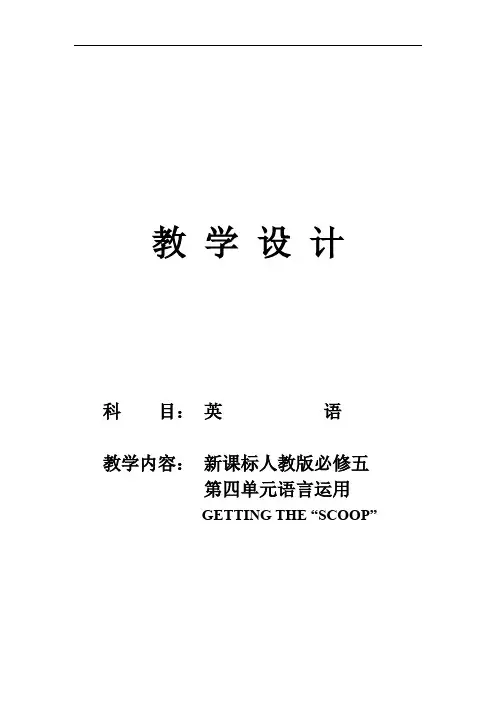
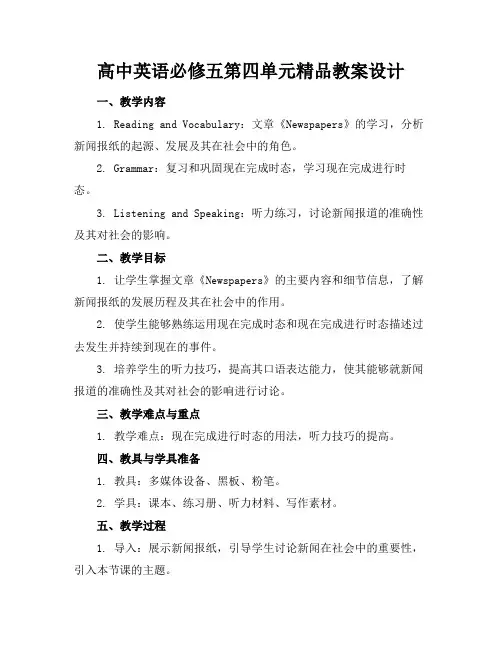
高中英语必修五第四单元精品教案设计一、教学内容1. Reading and Vocabulary:文章《Newspapers》的学习,分析新闻报纸的起源、发展及其在社会中的角色。
2. Grammar:复习和巩固现在完成时态,学习现在完成进行时态。
3. Listening and Speaking:听力练习,讨论新闻报道的准确性及其对社会的影响。
二、教学目标1. 让学生掌握文章《Newspapers》的主要内容和细节信息,了解新闻报纸的发展历程及其在社会中的作用。
2. 使学生能够熟练运用现在完成时态和现在完成进行时态描述过去发生并持续到现在的事件。
3. 培养学生的听力技巧,提高其口语表达能力,使其能够就新闻报道的准确性及其对社会的影响进行讨论。
三、教学难点与重点1. 教学难点:现在完成进行时态的用法,听力技巧的提高。
四、教具与学具准备1. 教具:多媒体设备、黑板、粉笔。
2. 学具:课本、练习册、听力材料、写作素材。
五、教学过程1. 导入:展示新闻报纸,引导学生讨论新闻在社会中的重要性,引入本节课的主题。
2. 阅读理解:学生阅读文章《Newspapers》,完成相应的练习题,教师对文章内容进行讲解和分析。
3. 语法讲解:通过例句,讲解现在完成时态和现在完成进行时态的用法,让学生进行随堂练习。
4. 听力练习:学生听新闻报道,完成听力练习,教师针对听力技巧进行讲解和指导。
5. 口语讨论:学生分组讨论新闻报道的准确性及其对社会的影响,教师给予指导和评价。
六、板书设计1. 文章《Newspapers》的主要内容和细节信息。
2. 现在完成时态和现在完成进行时态的用法。
3. 新闻评论的写作要点。
七、作业设计答案:学生完成的文章需包含新闻报道的主题、观点明确、论据充分、结构清晰。
八、课后反思及拓展延伸1. 教师反思:关注学生的学习效果,针对学生的掌握情况调整教学方法和节奏。
2. 拓展延伸:鼓励学生关注时事新闻,提高其英语素养,培养其独立思考和分析问题的能力。
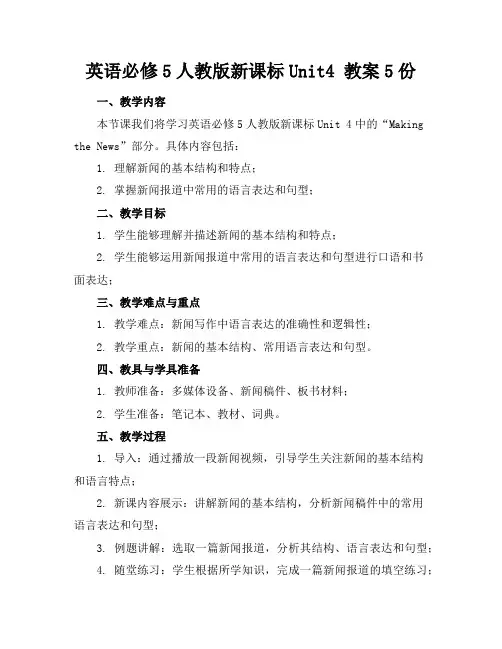
英语必修5人教版新课标Unit4 教案5份一、教学内容本节课我们将学习英语必修5人教版新课标Unit 4中的“Making the News”部分。
具体内容包括:1. 理解新闻的基本结构和特点;2. 掌握新闻报道中常用的语言表达和句型;二、教学目标1. 学生能够理解并描述新闻的基本结构和特点;2. 学生能够运用新闻报道中常用的语言表达和句型进行口语和书面表达;三、教学难点与重点1. 教学难点:新闻写作中语言表达的准确性和逻辑性;2. 教学重点:新闻的基本结构、常用语言表达和句型。
四、教具与学具准备1. 教师准备:多媒体设备、新闻稿件、板书材料;2. 学生准备:笔记本、教材、词典。
五、教学过程1. 导入:通过播放一段新闻视频,引导学生关注新闻的基本结构和语言特点;2. 新课内容展示:讲解新闻的基本结构,分析新闻稿件中的常用语言表达和句型;3. 例题讲解:选取一篇新闻报道,分析其结构、语言表达和句型;4. 随堂练习:学生根据所学知识,完成一篇新闻报道的填空练习;5. 小组讨论:分组讨论新闻报道的写作方法和技巧;六、板书设计1. 新闻基本结构:、、主体、;2. 新闻常用语言表达和句型:如“According to”, “It is reported that”等;3. 新闻报道写作要点。
七、作业设计信息:某城市举行了一场盛大的马拉松比赛,吸引了来自世界各地的选手参加,比赛过程中发生了感人的一幕。
2. 答案示例:Title: Touching Scene at the Marathon Race in a City Lead: The marathon race held in a city attracted runners from all over the world. A touching scene occurred during the race.Body: According to reports, a disabled runner3. 作业要求:不少于100词,使用本节课所学的新闻语言表达和句型。
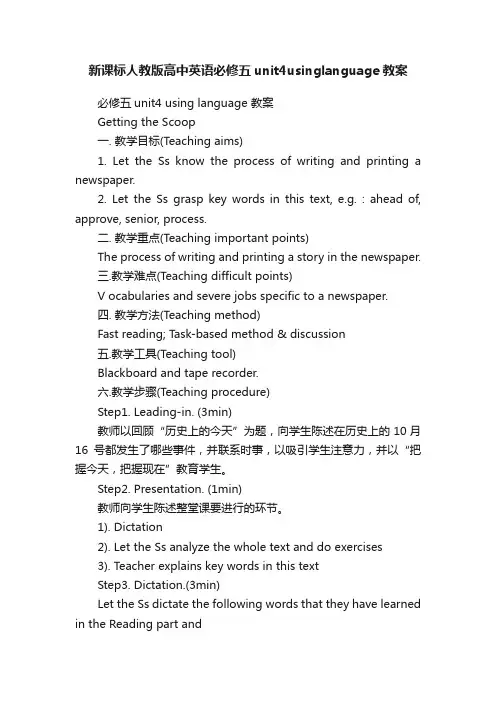
新课标人教版高中英语必修五unit4usinglanguage教案必修五unit4 using language 教案Getting the Scoop一. 教学目标(Teaching aims)1. Let the Ss know the process of writing and printing a newspaper.2. Let the Ss grasp key words in this text, e.g. : ahead of, approve, senior, process.二. 教学重点(Teaching important points)The process of writing and printing a story in the newspaper.三.教学难点(Teaching difficult points)V ocabularies and severe jobs specific to a newspaper.四. 教学方法(Teaching method)Fast reading; Task-based method & discussion五.教学工具(Teaching tool)Blackboard and tape recorder.六.教学步骤(Teaching procedure)Step1. Leading-in. (3min)教师以回顾“历史上的今天”为题,向学生陈述在历史上的10月16号都发生了哪些事件,并联系时事,以吸引学生注意力,并以“把握今天,把握现在”教育学生。
Step2. Presentation. (1min)教师向学生陈述整堂课要进行的环节。
1). Dictation2). Let the Ss analyze the whole text and do exercises3). Teacher explains key words in this textStep3. Dictation.(3min)Let the Ss dictate the following words that they have learned in the Reading part andchoose tow Ss dictate on the blackboard.delighted; admirable; assistant; concentrate on; inform; deadline; depend on; accuseof; dilemma; so as toAfter dictation, teacher checks the words that the two Ss wrote on the blackboard.Step4. Fast reading. (20min)1. Let the Ss listen to the tape to find out the main idea of this text. Teacher chooses one student to answer this question and complete the answer.2. Let the Ss read the first two para. quickly and ask one student to make the three steps on the blackboard in right order. After that,teacher checks the answer.3. Let the Ss read the third para. til the first sentence of the fouth papa. and ask one student to do the match on the blackboard. After that,teacher checks the answer.4. Let the Ss read the rest part of the text and ask one student to complete the chart on the blackboard. After that,teacher checks the answer.Step5. V ocabularies. (15min)1. Ahead of 在……之前;胜过;强于常用:be ahead of sth. ahead of time 提早;提前go ahead 前进;继续干;说下去(常用于口语)E.g. : ―May I open the window?―Go ahead! (表示赞同对方的观点)2. Senior 高级的,高年级的;年长的(联系junior一同学习)常用:be senior /junior to 比…年长∕年幼的E.g.: He is senior /junior to me by two years.他比我大∕小两岁Senior high school 高中Junior high school 初中※senior/junior 无比较级,不与than 搭配使用3. Approve 赞成;同意;认可;批准常用:approve sth. 批准某事E.g.: The leader approved our plan.领导批准了我们的计划。
Teaching DesignUnit4 Making the NewsGrammar: InversionI Teaching objectives1.Knowledge objectivemaster the key sentences structuresOnly after ... did sb...Only by doing ... could sb...Not only did...Seldom have I...2. Ability objectiveEnable the students to use inverted sentences correctly.3. Moral objectiveHelp the students learn how to use Inversion correctly.II.Taching important pointsHelp the students use Inversion correctly.III.Teaching difficult pointsGuide the students to summarize the usage of Inversion.IV.Teaching methodsTask-based learning; cooperative learning; practice.V.Teaching aidsA computer and a projector.VI.Teaching proceduresStep Ⅰ PresentationAsk the students to find the sentences of Inversion in the Reading.T: Today we are going to learn Grammar. In normal word order in a sentence the subject comes before the verb. But sometimes the order of the subject and the verb is reversed, which we call Inversion. Please find the sentences of Inversion in the reading passage on page 26.In a while, get the students to say the sentences. Then show the answers on the screen. Never will Zhou Yang forget his first assignment at the office of a popular English newspaper.Only when you have seen what he or she does, can you cover a story by yourself.Not only am I interested in photography, but I took a course at university, so it’s actually of special interest to me.Only if you ask many different questions will you acquire all the information you need to know.Step Ⅱ Explanation and SummaryT: Well, class, now I’d like to explain something about the inverted sentences so that you can have a better understanding of Inversion. Sometimes the order of the subject and the verb is reversed after the following adverbial elements:1) Adverbial expressions of negation or near negation with no, not, never, neither, seldom, scarcely, rarely, barely and hardly, etc.The same reversal of word order takes place after negative conjunctions like neither, nor, not only ... but also, no sooner ... than.e.g. In no case can an exception be made.Never have I seen such a stupid person.Not until he loses all his money will he stop gambling.Scarcely had he entered the room when he was knocked down by a stranger.Not only is she beautiful, but she is also very intelligent.I cannot attend the meeting tonight, and neither can my wife.2) Adverbial expressions with onlye.g. Only after an operation will he be able to walk again.Only once has he done such a thing.3) Adverbial expressions with soe.g. So greatly did he admire the beautiful actress he asked her to marry him.The word order is also reversed after the conjunction so.e.g. I caught a cold, and so did my wife.4) Adverbial expressions of placee.g. There stood the tallest man he had ever seen.Inside the room were a few pieces of furniture.But when the subject is a pronoun instead of a noun, the order should not be inverted.e.g. Here he comes.Off he ran.5) Other adverbials in initial positione.g. Loud and clear rang the bells.Often did we sit together without saying a word.Step Ⅲ PracticeT: To understand the Grammar better, we’ll do some practice. Now turn to page 29. Please do Exercises 2-4 on your own.After the students finish, check the answers.Step Ⅳ ConsolidationPresent the following exercises on the screen.T: Now let’s do more exercises to see how well you have grasped Inversion.Rewrite the following sentences using inversion.1.I shall not give her a gift until her birthday.Not until her birthday __________________.2. I realized what trouble he was in only when he told me.Only when __________________________3. If I had been informed earlier, I could have done something.4. The teacher said, “He is a clever boy.”5. A horse was in the distance.Do exercises on page29.Step Ⅴ SummaryVII.HomeworkPreview the reading passage in Using Language.品味人生1、不管鸟的翅膀多么完美,如果不凭借空气,鸟就永远飞不到高空。
2024年高中英语必修五unit4教案Unit 4 Teaching Plan for High School English (Compulsory) in 2024I. Teaching ContentThis unit is from the textbook’s fourth chapter, focusing on the theme of “Making a Difference”. Thedetailed content includes:1. Reading: “The Power of One”Understanding the story of how one individual can make a significant impact on society.Analyzing the author’s perspective and the persuasive techniques used.2. Grammar: Passive VoiceIdentifying and using passive voice in various contexts.Comparing active and passive voice structures.3. Listening and Speaking: “Creating Change”Engaging in conversations about social issues and possible solutions.Practicing how to express opinions and justify them with reasons.II. Teaching ObjectivesBy the end of this unit, students will be able to:1. Comprehend and analyze texts that explore the theme of making a difference.2. Use passive voice accurately in written and spoken English.3. Engage in discussions, express opinions, and propose solutions to social issues.III. Teaching Difficulties and PrioritiesDifficulty: Mastering the use of passive voice in different contexts.Priority: Developing critical thinking skills through the analysis of texts and engaging in discussions.IV. Teaching and Learning MaterialsTextbookHandouts with additional exercisesVisual aids (posters, charts)Audio recording for listening activitiesV. Teaching Process1. Warmup (5 minutes)2. Reading (25 minutes)Prereading: Skimming the text for main ideas.Whilereading: Indepth analysis of the text, focusing on persuasive techniques and vocabulary.Postreading: Group discussion on the author’s message and its relevance to reallife situations.3. Grammar (20 minutes)Presentation: Introducing passive voice through examples and explanations.Practice: Guided exercises, both written and spoken, to reinforce understanding.Application: Students create their own sentences using passive voice to describe social initiatives.4. Listening and Speaking (20 minutes)Speaking: Group roleplays where students discuss and propose solutions to social issues.5. Summary (10 minutes)Recap of the main points from the lesson.Q&A session to address any doubts or questions.VI. Blackboard DesignMain “Unit 4: Making a Difference”Subheadings: “Reading Analysis”, “Grammar: Passive Voice”, “Listening & Speaking”Key vocabulary and phrases listed on one side.Space for writing examples and important notes.VII. Homework DesignExample Answer: Air pollution is a significant issue affecting our town. Measures, such as the installation of filters in factories and car inspections, should be taken to reduce it.2. Prepare a 2minute speech about an individual who has made a difference in history or present times, and present it in the next class.Example Answer: “The Impact of Malala Yousafzai on Girls’ Education”VIII. Afterclass Reflection and ExtensionReflect on the effectiveness of the practical scenarios and group discussions in engaging students.Assess the students’ understanding of passive voice through their homework and provide additional practice if needed.Encourage students to research and present on othersocial issues, extending their knowledge beyond the classroom.重点和难点解析1. 教学难点:被动语态在各种情境中的运用。
2024年英语必修5人教版新课标Unit4 教案5份一、教学内容二、教学目标1. 了解并掌握与未来相关的词汇、短语和句型;2. 能够运用所学知识进行情景对话,表达自己对未来职业的期望;3. 培养学生的创新意识和职业规划意识。
三、教学难点与重点重点:与未来相关的词汇、短语和句型的掌握,情景对话的运用。
难点:词汇、短语的正确运用,句型的熟练运用。
四、教具与学具准备教具:PPT、黑板、粉笔、教学卡片等。
学具:课本、笔记本、练习本等。
五、教学过程1. 导入:通过展示未来交通工具和职业的图片,引导学生讨论对未来生活的期待,激发学生学习兴趣。
2. 新课内容呈现:a. 教师带领学生一起学习Chapter 1 The Future of Transportation,讲解重点词汇和句型;b. 学生进行小组讨论,运用所学词汇和句型进行情景对话;c. 教师展示Chapter 2 My Future Career,引导学生学习相关词汇和句型;d. 学生进行个人陈述,表达自己的未来职业规划。
3. 例题讲解:针对本节课的重点内容,讲解典型例题,帮助学生巩固所学。
4. 随堂练习:学生完成教师布置的练习题,巩固所学知识。
六、板书设计板书分为两部分:1. Chapter 1 The Future of Transportation:a. 重点词汇;b. 重点句型。
2. Chapter 2 My Future Career:a. 重点词汇;b. 重点句型。
七、作业设计1. 作业题目:a. 用所学的词汇和句型编写一段关于未来交通工具的对话;b. 以“My Future Career”为题,写一篇短文,描述自己的未来职业规划。
八、课后反思及拓展延伸1. 课后反思:教师针对本节课的教学效果进行反思,找出不足之处,以便改进教学方法。
2. 拓展延伸:鼓励学生课后收集关于未来职业的资料,了解不同职业的特点和要求,为未来的职业规划做好准备。
同时,教师可推荐相关英文资料,提高学生的英语阅读能力。
Section_ⅡWarming_Up_&_Reading_—_Language_Points一、这样记单词记得准·写得对记得快·记得多Ⅰ.基础词汇1.update v t.更新;使现代化2.acquire v t. 获得;取得;学到3.assess v t. 评估;评定4.meanwhile ad v. 其间;同时5.case n. 状况;病例;案例6.accuse v t. 指责;责怪;控告7.deliberately ad v. 有意地8.dilemma n. (进退两难的)逆境;窘境9.demand n. 需求;要求v t. 猛烈要求10.publish v t. 出版;发行;发表;公布11.thorough adj. 彻底的;详尽的12.gifted adj. 有天赋的Ⅱ.拓展词汇1.photograph n.照片v t.给……照相→photographer n.摄影师→photography n.摄影2.delighted adj.欢快的;欣喜的→delight v t.使兴奋→delightful adj.令人开心的3.admirable adj.值得赞扬的;令人鄙视的→admire v t.鄙视→admiration n.鄙视;观赏4.unusual adj.不同寻常的;独特的→usual adj.寻常的;通常的1.journalist n.记者;新闻工作者[同义]reporter[联想](1)媒体从业者①editor n.编辑②chief editor n.主编③photographer n.摄影师④host/hostess n.主持人(2)媒体类型①daily n.日报②weekly n.周刊③journal n.杂志④mass media大众传播媒体2.deadline n.最终期限[词块]meet the deadline 赶上最终期限;按时完成[联想]headline n.新闻标题;内容提要3.amateur n.业余爱好者adj.业余的[联想]professional n.专业人员adj.专业的;职业的4.colleague n.同事[联想]①companion同伴;伙伴②teammate队友③deskmate同桌④classmate同学5.meanwhile ad v.其间;同时[同义]at the same time; in the meantime6.deliberately ad v.有意地[同义]by design; on purpose[反义]by accident7.publish v t.出版;发行;发表;公布5.assist v t.挂念;帮忙;救济→assistant n.助手;助理;售货员→assistance n.挂念;帮忙6.profession n.职业;专业→professional adj.专业的;职业的n.专业人员7.concentrate v i.&v t.集中;聚集→concentration n.认真;专注rm v t.告知;通知→information n.信息9.guilty adj.犯罪的;有罪的;内疚的→guiltn.怀有负罪感10.technical adj.技术(上)的;技巧方面的→technically ad v.技术上;工艺上[同义]come out出版;发行(为不及物动词短语)8.gifted adj.有天赋的[同义]talented[词块]①be gifted/talented at music在音乐方面有天赋②a gifted/talented musician一位有天赋的音乐家[联想]“-ed”结尾的形容词一览①coloured adj.加颜色的②limited adj.有限的③curved adj.弯曲的④canned adj.罐装的9.以“-able”为后缀的高频形容词小结①suit→suitable合适的②value→valuable贵重的③enjoy→enjoyable令人开心的④accept→acceptable可接受的记坚固定短语多积常用词块1.concentrate_on集中;全神贯注于2.have_a_nose_for 对……敏感3.inform_sb.of/about_sth. 通知某人某事4.keep_in_mind 记在心头;记住5.depend_on/upon 依靠;依靠6.accuse_..._of 因……指责或控告……7.so_as_to_(do_sth.) 为了(做)……8.look_forward_to 期望;期望1.work experience工作阅历2.good communication skills 良好的沟通技能3.an experienced journalist 一名有阅历的记者4.cover a story 进行新闻采访5.take an amateur course 参与业余课程6.tell the whole truth 说出全部真相7.miss the deadline 延误任务规定的期限8.a trick of the trade 行业诀窍先背熟再悟通后仿用1.His discussion with his new boss,Hu Xin (HX), was to stronglyinfluence his life as a journalist.他同新上司胡新的争辩对他的记者生涯必将产生重大的影响。
人教版| 必修5重点词汇、短语、句型、语法全汇总Unit 4 Making the News【重点词汇、短语】1. delighted 快乐的,欣喜的2. assist 帮助,协助3. process 加工,处理,过程,程序4. concentrate on 集中,聚集5. acquire 获得,学到6. assess 评估,评定7. inform 通知8. depend on 依靠9. accuse… of 控告10. so as to 为了11. demand 需求,要求12. ahead of 在…前面13. approve 许可,批准【重点句型】1. Never will Zhou Yang forget his first assignment at the office of a popular English newspaper.周阳永远不会忘记他在一家知名的英语报报社第一天上班的工作任务。
2. You’ll find your colleagues very eager to assist you, so you may be able to concentrate on photography later if you’re interested.你将会发现你的同事们会热情地帮助你,如果你对摄影感兴趣,以后你可以集中精力去钻研。
3. Not only am I interested in photography, but I took an amateur course at university to update my skills.对摄影我不只是感兴趣,在大学里我还专修过业余摄影课来更新我的技术。
4. Only if you ask many different questions will you acquire all the information you need to know.只有提很多不同的问题,你才能收集到你需要的信息。
Unit 4 Module 5 Making the news单元教学目标talk about jobs in a newspapertalk about the basic qualities and skills a journalist should havelearn about the writing and printing process for an article and what is the primary source and the second sourcelearn how to use Inversion correctlylearn how to make an appointmentwrite a newspaper article教材重组及课型设计1st period Reading(整合warming up, Pre-reading, Reading 与Comprehending四部分)2nd period words & expressions(整合Learning about Language 中的Discovering useful words and expressions与Workbook中的Using words and expressions)3rd period Grammar(整合Learning about Language 中的Discovering Structures与Workbook中的Using Structures)4th period Extensive Reading(整合Using Language 中的Reading与Workbook中的Reading Task)5th& 6th period Speaking and Writing ((整合Workbook中的SPEAKING TASK and WRITING TASK)7 th period Listening and Speaking(整合Using language 中的Listening and Speaking 与Workbook中的Listening, Talking)The 1st Period Reading(整合warming up, Pre-reading, Reading 与Comprehending四部分)Teaching Aims:1.Enable the students to talk about the qualities needed to be a good reporter and how to conduct a good interview2. Enable the students to learn some reading strategies3. Enable the students to learn the necessary qualities in their future jobImportant Points and difficult pointsLearn about how to be a good reporterTeaching methodsStrategic reading method; Task-based methodTeaching procedures:I. Elaboration (warming up): Help the students to relate their known knowledge to the topic that will be learnedTask2: Predict what is going to be learned by looking at the title of the text.Which type of job will be talked about in the text?II. Prediction (pre-reading):Task 3: Predict the main idea of the text by discussing the following questions:1. What are the qualities a good news reporter needs to have?(Have group discussion first and then finish Part 1 individually)2. What your first day at school was like? How would you feel on your first day at work? (Group discussion)III. Skimming, scanning, analyzing (Reading & Comprehending)Task 4: Read the text quickly to get a general idea of the text.Task 5: Divide the passage into three sections and match the following main ideas to the three sections:How to get an accurate storyTask 6 Read quickly to find out the information to fill in the form belowTask 7: Tell what is required for a reporter and a photographerpatient; imaginative ; well-organized; technically good; polite; concise; thorough; creative; curious; careful; gifted; professional。